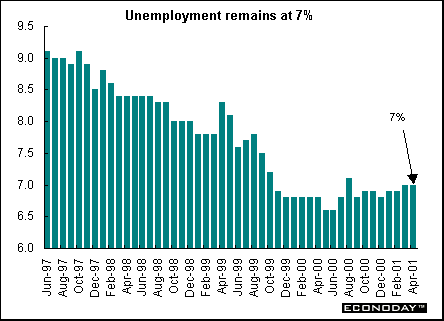
Indicator scoreboard
EMU - March industrial producer prices (excluding construction) rose 0.1 percent and 4.1 percent when compared with last year. Intermediate goods, including energy slipped 0.1 percent, offsetting continued strong increases for durable (up 0.3 percent) and non-durable (up 0.5 percent) consumer goods prices. Capital goods prices were flat, after rising 0.2 percent in February.

Germany - March manufacturing orders sank 4.4 percent and fell 1.1 percent when compared with last year. Domestic orders dropped 2.3 percent and foreign orders plummeted 7 percent. West German orders fell 4.2 percent and sank 6.5 percent in east Germany. Orders for durable and non-durable goods posted the biggest decline, down 5.1 percent, with both domestic (down 5.9 percent) and foreign demand (down 4.2 percent) showing large drops. Capital goods orders fell 3.8 percent in March, with a large 9.3 percent drop in foreign demand more than offsetting a 1.8 percent rise in domestic orders.

March seasonally adjusted pan German industrial production plummeted 3.7 percent. It sank 3.4 percent in west Germany and dropped 5.7 percent in east Germany. The decline was due partially to a drop in the construction sector that was at least partly weather related. These data will be revised in about 2 weeks. The manufacturing sector, which makes up about 80 percent of overall industrial output, declined 3.0 percent.

April seasonally adjusted pan German unemployment rose 6,000. This was the fourth month in a row that the number of unemployed increased. The west German number of unemployed rose 14,000 while the east German number dropped 8,000. Both March and February unemployment data were revised to show larger increases in adjusted joblessness than previously reported. The seasonally adjusted unemployment rate stayed at 9.3 percent.

March unadjusted trade surplus was DM17.2 billion. Exports jumped 7.8 percent and 7.5 percent when compared with last year. Imports increased 3.7 percent and 2.1 when compared with last year. Imports from other EMU states rose 2.0 percent while imports from non-EU nations increased 4.9 percent.
April final unadjusted consumer price index was revised up to 0.4 percent and 2.9 percent when compared with last year. Price increases during April came from higher prices for meat, fruits, fish and vegetables.
March real retail sales (both including and excluding auto dealerships, petrol stations and wholesale warehouses) declined 0.6 percent when compared with last year. This added to perceptions that consumer spending remains subdued despite the income tax cut that took effect at the beginning of the year. Real seasonally adjusted retail sales including autos and gas stations declined one percent when compared with last year.

France - April seasonally adjusted consumer prices rose 0.4 percent and 1.9 percent when compared with last year. Seasonally adjusted core inflation rate, which excludes administered prices, volatile sectors like food and energy, and tax effects, rose 0.2 percent and 1.5 percent when compared with last year. The harmonized inflation rate rose 0.6 percent on the month and 2.0 percent on the year.
Spain - March workday adjusted industrial production dropped 1.6 percent when compared with last year. Large declines were recorded in all sectors. Consumer goods production was down 2.4 percent confirming the weakening in domestic demand; capital goods production declined 2.2 percent while intermediate goods output fell by 1.0 percent.
Britain - March industrial production fell 0.2 percent and was down 0.1 percent when compared with last year. March manufacturing output declined 0.3 percent but rose 0.4 percent vs. a year ago. First quarter manufacturing output fell 0.7 percent but was still up 1.1 percent when compared with the first quarter of 2000. In the three months to March, industrial output fell 0.7 percent on the previous three months and was up 0.6 percent on the year earlier period.

Asia
Japan - March seasonally adjusted household spending by households of at least two people dropped 3.3 percent but rose 1.5 percent when compared with last year. Consumers cut back on repairs to their homes, education, food, transport, clothes and entertainment. The only bright spot in the spending report was the purchase of household appliances, which rose 14.4 percent. The new recycling law charges people to dispose of old refrigerators, washing machines, air conditioners and televisions. That caused a buying rush as consumers bought new items to avoid the charge.
March seasonally adjusted core machinery orders were down 3.6 percent from February. Core orders in the January to March period were down 7.0 percent on the quarter, marking the first quarterly decline in almost two years. Unadjusted core orders also rose 5.7 percent from the year earlier month. Machinery orders are widely regarded as a leading indicator of corporate capital investment. Core orders exclude those from electric power companies and those for ships, which are often a source of volatility in the overall data due to their large sizes.
Australia - April seasonally adjusted employment rose 40,100, the most since July 2000. However, the unemployment rate rose to 6.8 percent as more people looked for work.
Americas
Canada - April seasonally adjusted employment edged up by an estimated 25,200 with all the gains in full time employment. Part time employment was virtually unchanged. The unemployment rate remained at 7 percent. The participation rate was unchanged at 66.1 percent. Almost two-thirds of the April growth was among private sector employees, continuing their long-term upward trend. The number of public sector employees changed little, as did the number of self-employed. Goods-producing industries were up 3,900 jobs, and the service producing sector up 21,300 jobs.



Introduction • Global Stock Market Indexes • Recap of Global Markets • Currencies • Indicator Scoreboard

The Bottom Line • Looking Ahead
|